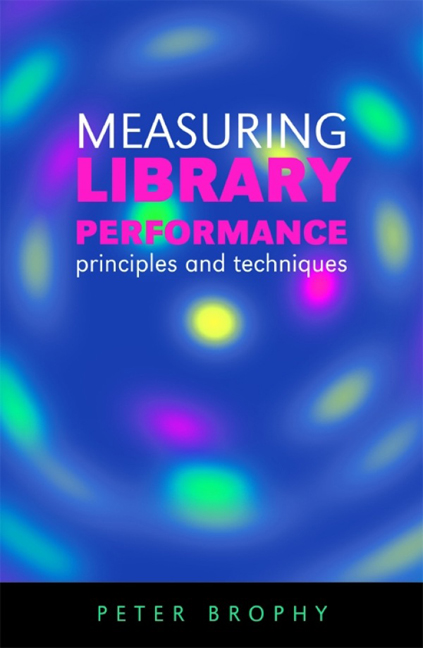Book contents
- Frontmatter
- Contents
- List of figures
- List of tables
- Preface
- Acronyms and abbreviations
- 1 Background
- 2 Theoretical considerations
- 3 User satisfaction
- 4 Impact on users
- 5 Social and economic impact
- 6 Inputs
- 7 Processes
- 8 Outputs
- 9 Staff
- 10 Infrastructure
- 11 Services for all
- 12 Benchmarking
- 13 The balanced scorecard
- 14 Standards
- Appendix 1 Data collection methods
- Appendix 2 The analysis of data
- Appendix 3 The presentation of results
- Index
- Frontmatter
- Contents
- List of figures
- List of tables
- Preface
- Acronyms and abbreviations
- 1 Background
- 2 Theoretical considerations
- 3 User satisfaction
- 4 Impact on users
- 5 Social and economic impact
- 6 Inputs
- 7 Processes
- 8 Outputs
- 9 Staff
- 10 Infrastructure
- 11 Services for all
- 12 Benchmarking
- 13 The balanced scorecard
- 14 Standards
- Appendix 1 Data collection methods
- Appendix 2 The analysis of data
- Appendix 3 The presentation of results
- Index
Summary
■ Introduction
Libraries rely heavily on their infrastructure for the delivery of services. The library building is the most prominent and probably most expensive part of that infrastructure but information and communications technology facilities will be of almost the same importance. Clearly it is imperative that the performance of these investments be monitored to ensure that they are helping the library deliver value, and that they are not in themselves an untoward constraint.
■ The library building
The building from which services are delivered is a very significant input to library service as a whole, especially in relation to those services that require the user to come to the building, such as physical book lending or access to workstations. At one time it was usual for detailed norms to be published for the building itself, often by government agencies, and although this is now less common it is an approach which can still be found. Compliance with such standards is then the basic measure of performance. An example of this approach can be found in the ‘Library building standards’ published by the State of Queensland in Australia (www.slq.qld.gov.au/serv/publib/policy/guidelines/four). These suggest, for example, that for a main branch library the total floor area should be related to population size:
• Population: 10,000–15,000 there should be between 49 and 45 m2 per 1000 population
• Population: 15,000–50,000 there should be between 45 and 41 m2 per 1000 population
• Population: 50,000–100,000+ there should be between 41 and 37 m2 per 1000 population.
The standards also state that for a new library there should be space for each of the functions listed in Figure 10.1. This then becomes a checklist against which performance can be measured.
Note that all of these are inputs to the service. The fact that there is, for example, a ‘toys and games area’ tells us nothing about what has been provided there, who has used that area or what effect that use had on them. This is not to say that such information is useless: unless a library has this kind of designated area it might be very difficult to attract very young children. As was stressed in Chapter 6, ‘Inputs’, these performance indicators thus take us to the first stage and tell us something about that library's capabilities.
- Type
- Chapter
- Information
- Measuring Library Performanceprinciples and techniques, pp. 129 - 137Publisher: FacetPrint publication year: 2006



